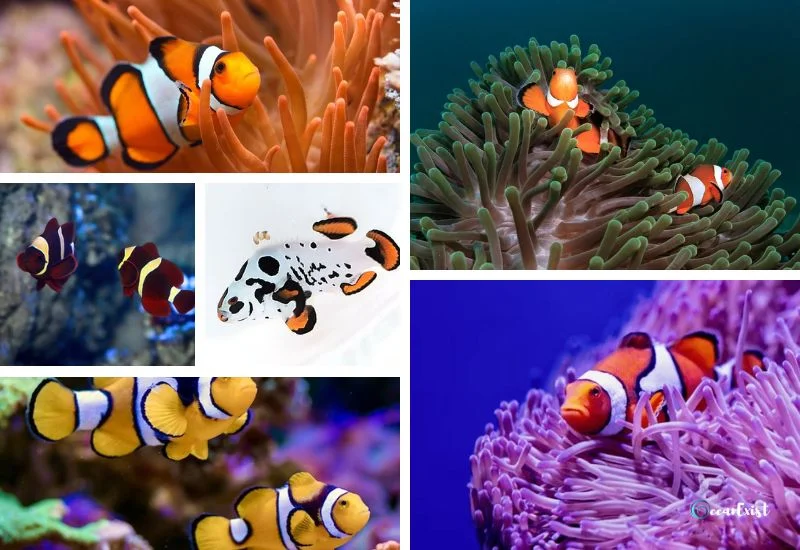Clownfish are undoubtedly the most pet fish worldwide because of their striking colors and beautiful patterns. Every aquarist has at least a pair of clownfish.
Do you wish to add clownfish to your reef but are still confused?
I know why you are confused.
Upon arriving at an aquarium, you come to know that Clownfish have thirty-plus varieties. And you can not make up your mind about which one to pet.
But we have got your back.
We have researched and gathered all the information an aquarist needs. Here is the list of 20 types of clownfish with their pictures and necessary information that you can consider adding to your aquarium.
Along with the essential introduction to each clownfish, you will also come to know amazing facts about each type of clownfish.
This blog contains:
- Scientific Name
- Colors
- Their weight
- Maximum Length
- Food or Diet
- Tank Size
- Lifespan
Let’s get down to business quickly.
1. Orange Clownfish (Amphiprion percula)
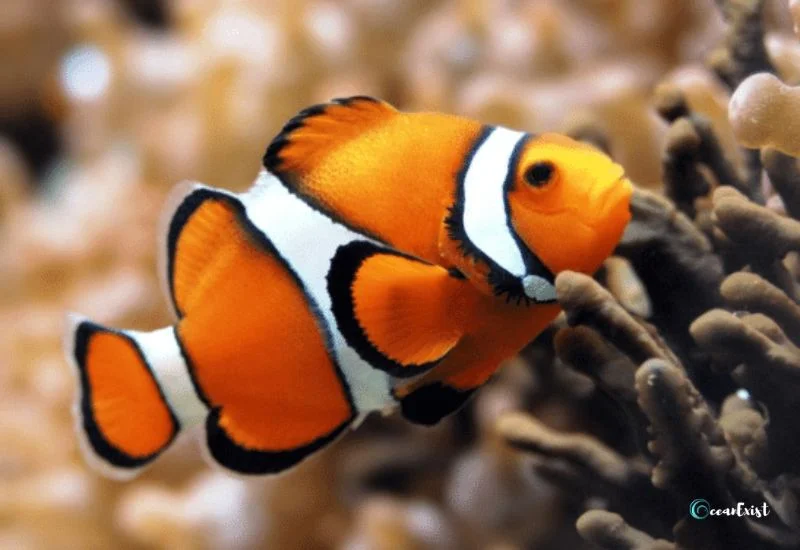
So, here it is. The most common and popular clownfish around the globe is the Orange Clownfish.
They are also called the Percula Clownfish. They have bright orange bodies with white bands outlined in black.
They are found in the Indo-Pacific region and are prevalent in marine aquariums. They can grow up to 4 inches and live around 6 – 10 years in the wild.
- Scientific Name: Amphiprion percula
- Colors: Vibrant orange with white bands outlined in black
- Weight: 8-15 grams
- Maximum Length: 4 inches (10 cm)
- Food/Diet: algae, small crustaceans, and fish flakes
- Tank Size: 20 gallons
- Lifespan: 6-10 years
2. Saddleback Clownfish (Amphiprion polymnus)
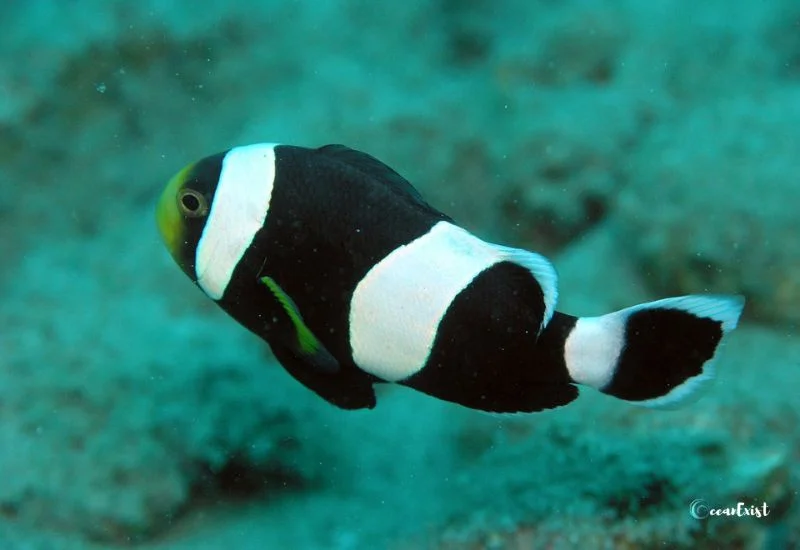
Saddleback Clownfish are recognizable by their distinctive saddle-like marking behind the head. Saddleback Clownfish are native to the Indo-Pacific.
They have varying color patterns. Their colors range from deep red to black and have contrasting white or yellow.
- Scientific Name: Amphiprion polymnus
- Colors: Yellow-orange with a distinctive saddle marking behind the head
- Weight: 10-20 grams
- Maximum Length: 5 inches (13 cm)
- Food/Diet: algae, small invertebrates, and prepared fish food
- Tank Size: 30 gallons
- Lifespan: 6-8 years
3. Pink Skunk Clownfish (Amphiprion perideraion)
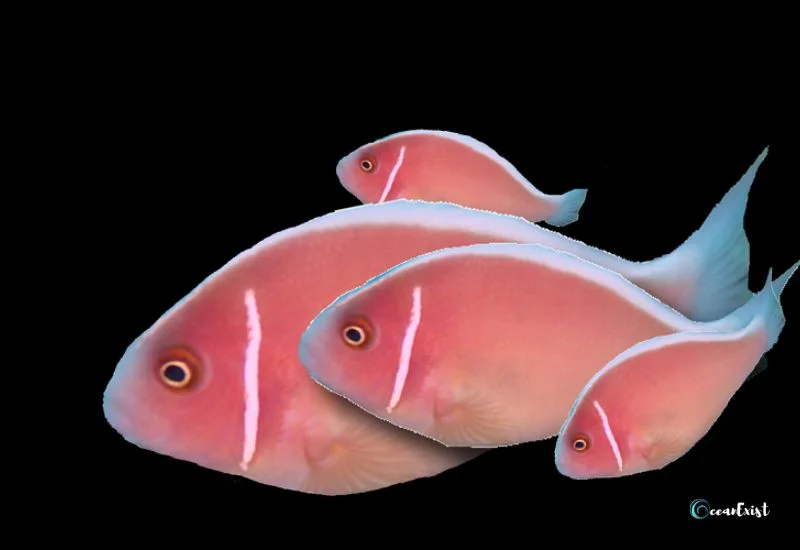
The Pink Skunk Clownfish has a unique pinkish hue. They are named for the broad stripe from their head to their tail. They are commonly found in Southeast Asia and the Pacific Ocean.
Their easy care and affordability make them one of the most common clownfish types among aquarists.
- Scientific Name: Amphiprion perideraion
- Colors: Pale pink with a white head stripe and black edges
- Weight: 5-10 grams
- Maximum Length: 4 inches (10 cm)
- Food/Diet: prefers zooplankton, algae, and commercial fish foods
- Tank Size: 20 gallons
- Lifespan: 4-6 years
4. Wide-Band Anemonefish (Amphiprion latezonatus)
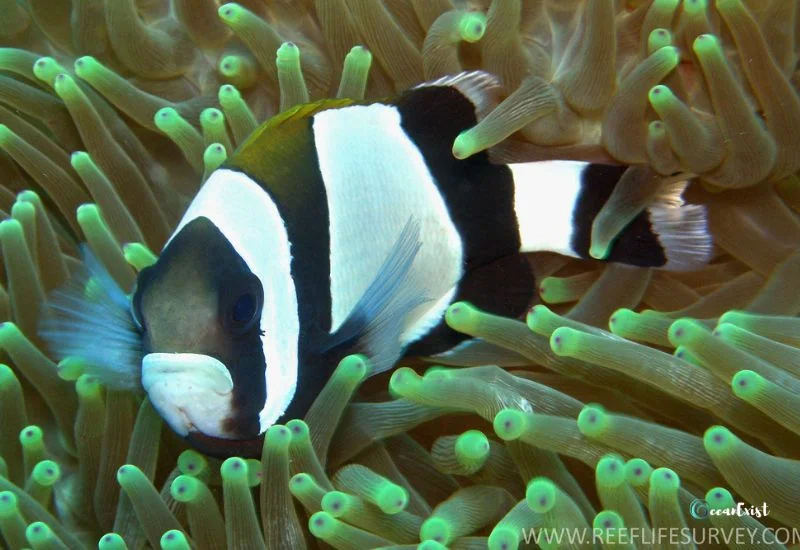
Wide-band clownfish are known for their broad, white bands. The bands encircle their bodies. They inhabit reefs and lagoons in the western Pacific Ocean.
- Scientific Name: Amphiprion latezonatus
- Colors: Bright orange with wide vertical white bands
- Weight: Varies,10-15 grams
- Maximum Length: 5 inches (13 cm)
- Food/Diet: algae, small invertebrates, and fish pellets
- Tank Size: 30 gallons
- Lifespan: 8-12 years
5. Snowflake Clownfish (Amphiprion ocellaris)
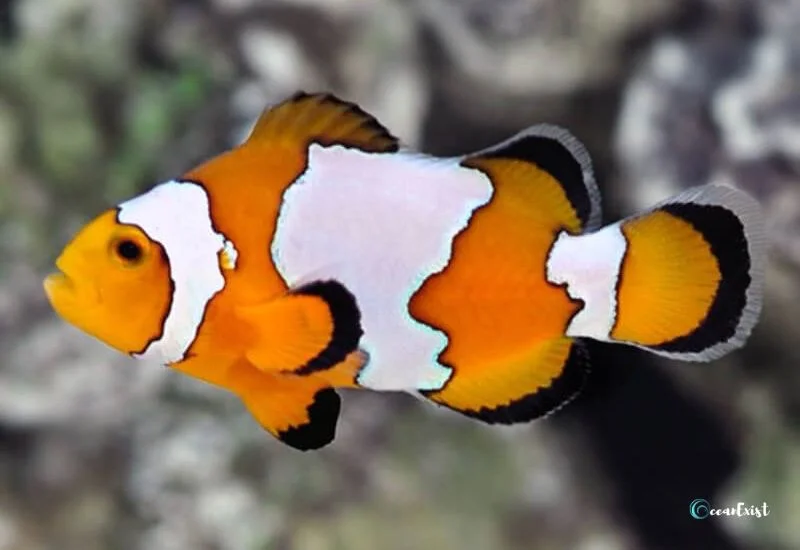
The Snowflake Clownfish is a type of the Ocellaris Clownfish. These fish are one of the most common breeds, obtained easily by selective breeding.
They have white spots on their oranges. The only difference between Snowflake and Ocellaris is spot size.
Having different varieties such as snowflake ocellaris, premium snowflake ocellaris, and ultra snowflake ocellaris, they are widespread and famous in the aquarium trade.
- Scientific Name: Amphiprion ocellaris
- Colors: White to light orange with irregular black markings
- Weight: 5-12 grams
- Maximum Length: 4 inches (8 cm)
- Food/Diet: algae, plankton, and small crustaceans
- Tank Size: 10 gallons
- Lifespan: 6-8 years
6. Maroon Clownfish (Premnas Biaculeatus)
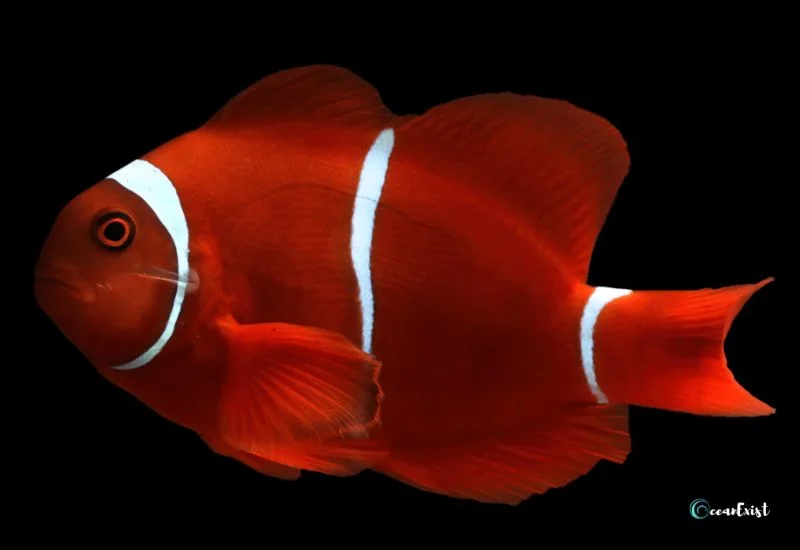
Gold stripe maroon clownfish, as the name suggests, have golden color strips all over the body. Their body’s primary color is maroon.
Being large fish growing up to 6 inches, they are one of the most sought-after fish. Interestingly, the maroon clownfish do not develop their colors when they are at least 1 year old.
- Scientific Name: Premnas biaculeatus
- Colors: Deep red to maroon with golden bands
- Weight: 10–20 grams
- Maximum Length: 6 inches (15 cm)
- Food/Diet: algae, small crustaceans, and fish flakes
- Tank Size: 30 gallons
- Lifespan: 6–8 years
7. Sebae Clownfish (Amphiprion sebae)
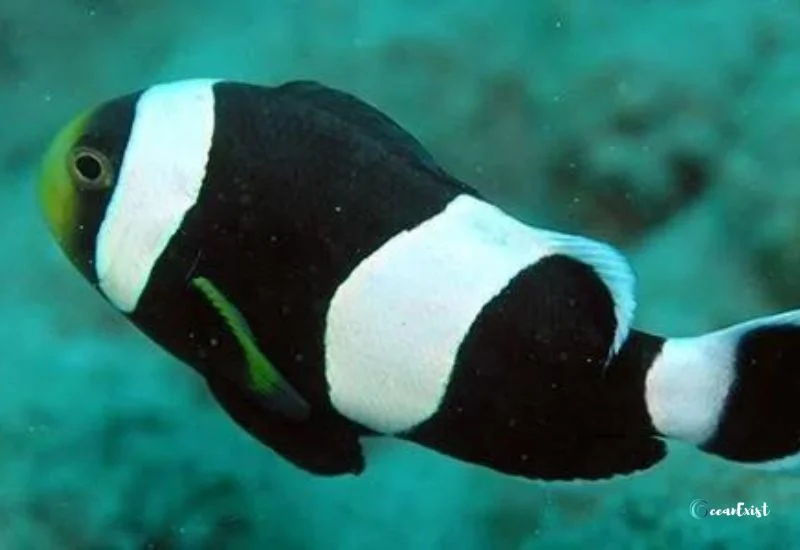
Sebae Clownfish feature stunning colors: black and yellow with vertical white stripes. They inhabit the warm waters of the Indian and Pacific Oceans.
They grow up to 5 inches. Their distinctive patterns make them one of the best and most fantastic clownfish.
- Scientific Name: Amphiprion sebae
- Colors: Yellow-orange with darker orange markings
- Weight: 10-20 grams
- Maximum Length: 5 inches (13 cm)
- Food/Diet: prefers zooplankton, algae, and commercial fish foods
- Tank Size: 30 gallons
- Lifespan: 6-8 years
8. McCulloch’s Anemonefish (Amphiprion mccullochi)
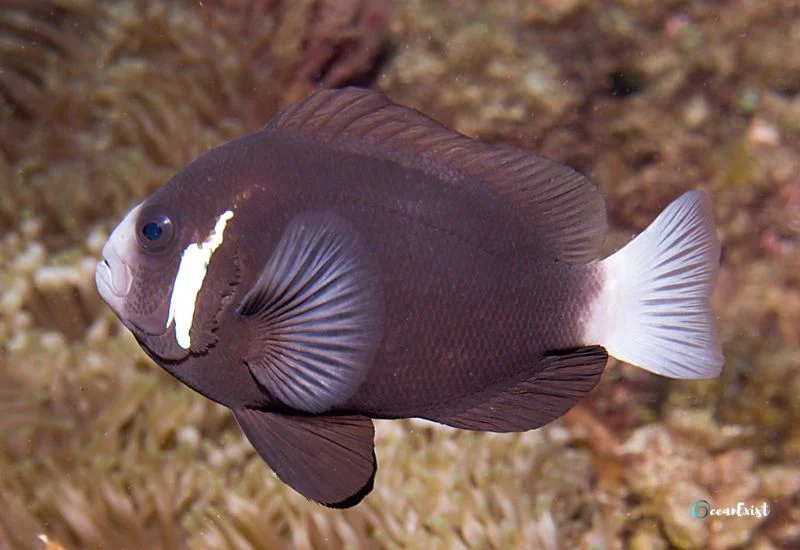
McCulloch’s Clownfish showcases an attractive orange coloration with thin white bands. They are endemic to some areas of Australia.
- Scientific Name: Amphiprion mccullochi
- Colors: Bright orange with a white stripe along the dorsal fin
- Weight: Varies,5-15 grams
- Maximum Length: 4 inches (10 cm)
- Food/Diet: algae, small invertebrates, and fish pellets
- Tank Size: 20 gallons
- Lifespan: 6-10 years
9. Barber’s Clownfish (Amphiprion barberi)
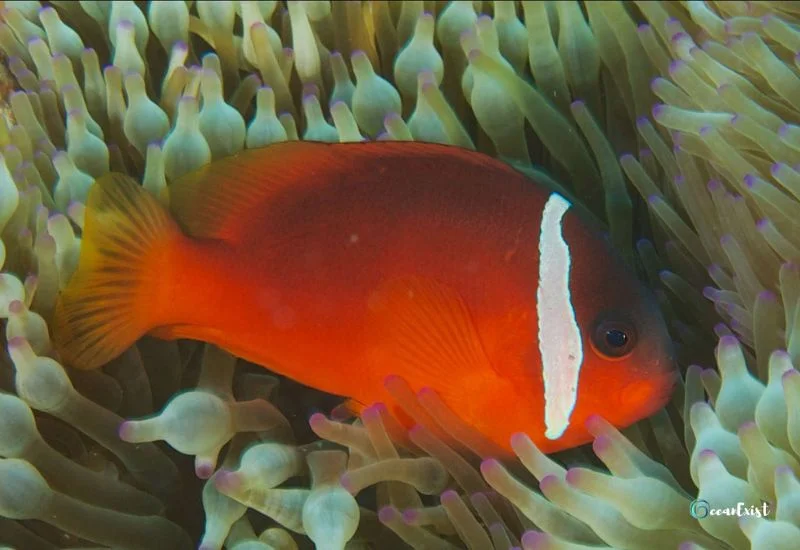
Barber’s Clownfish are known for their striking black and white colors. They look like a barber’s pole. They are found in the waters of Fiji and Tonga.
- Scientific Name: Amphiprion barberi
- Colors: Light orange with white bands
- Weight: 5-10 grams
- Maximum Length: 3 inches (8 cm)
- Food/Diet: algae, plankton, and small crustaceans
- Tank Size: 10 gallons
- Lifespan: 4-6 years
10. Orange Skunk Clownfish (Amphiprion sandaracinos)
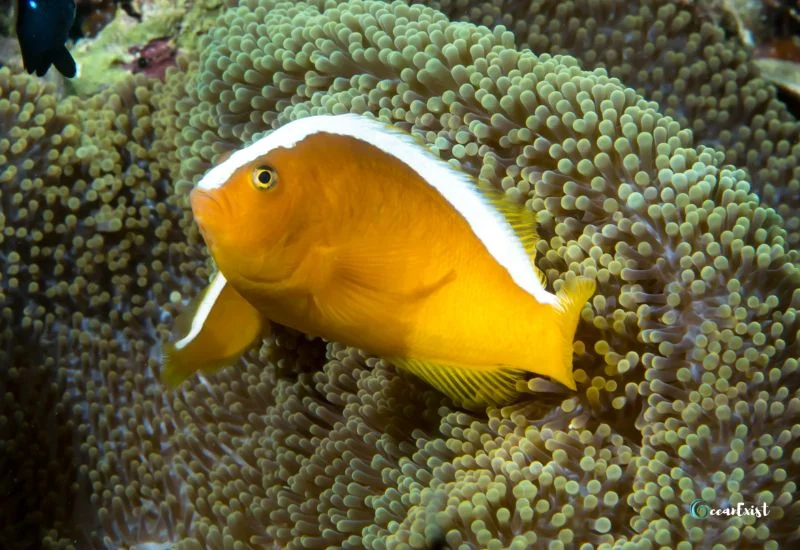
The Orange Skunk Clownfish has a bright orange with a narrow white stripe. They are native to the Western Pacific Ocean. They’re named after the distinctive skunk-like stripe.
- Scientific Name: Amphiprion sandaracinos
- Colors: Bright orange with a white head stripe and black edges
- Weight: 5-12 grams
- Maximum Length: 4 inches (10 cm)
- Food/Diet: algae, small invertebrates, and fish pellets
- Tank Size: 20 gallons
- Lifespan: 6-8 years
11. Picasso Clownfish (Amphiprion percula)
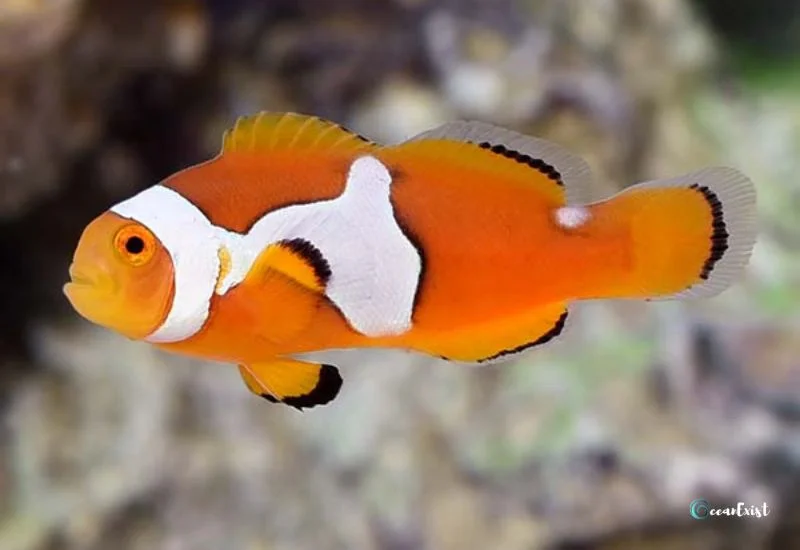
Picasso Clownfish, a unique variant of the Percula Clownfish, exhibits irregular patterns and markings on them like snowflakes.
These markings make each individual visually distinct. They can grow up to 4 inches and eat algae and other small crustaceans. these are the most common fish among aquarists.
Picasso clownfish has two variants: Picasso clownfish and Premium Picasso clownfish.
- Scientific Name: Amphiprion percula
- Colors: White with irregular black markings
- Weight: 5-10 grams
- Maximum Length: 3 inches (8 cm)
- Food/Diet: algae, plankton, and small crustaceans
- Tank Size: 10 gallons
- Lifespan: 6-8 years
12. Allard’s Clownfish (Amphiprion allardi)
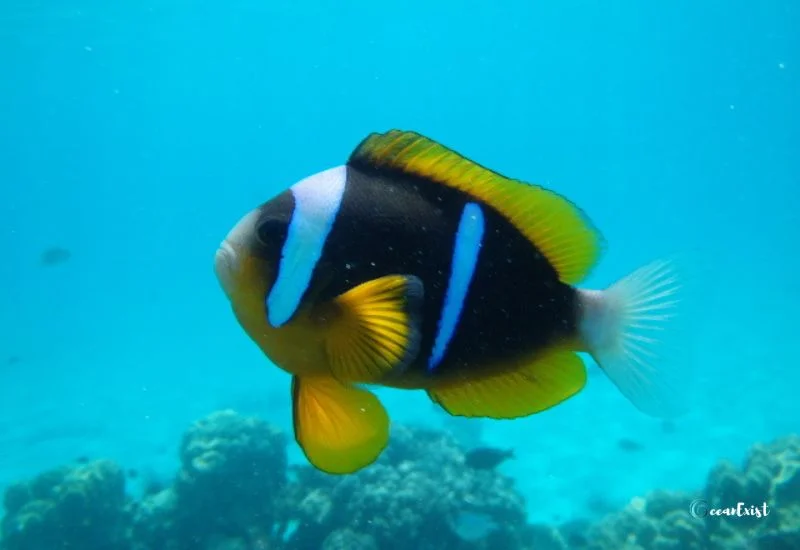
Allard’s Clownfish showcases a pale yellow adorned with striking black markings. They are endemic to New Caledonia and surrounding areas.
Allard’s clownfish grow up to 4 inches and live up to 6 to 8 years.
- Scientific Name: Amphiprion allardi
- Colors: Bright orange with black margins on fins
- Weight: Varies,5-15 grams
- Maximum Length: 4 inches (10 cm)
- Food/Diet: algae, small invertebrates, and fish pellets
- Tank Size: 20 gallons
- Lifespan: 6-8 years
13. Red Sea Clownfish (Amphiprion bicinctus)

The Red Sea Clownfish is native to the Red Sea. They are known for their bold coloration. These fish have white bands that contrast with their dark.
They grow up to 4 inches and eta algae and other commercial food. The required tank for these fish is 20 gallons for a pair.
- Scientific Name: Amphiprion bicinctus
- Colors: Orange-red with white bands
- Weight: 5-12 grams
- Maximum Length: 4 inches (10 cm)
- Food/Diet: prefers zooplankton, algae, and commercial fish foods
- Tank Size: 20 gallons
- Lifespan: 6-8 years
14. Frostbite Clownfish (Amphiprion ocellaris)
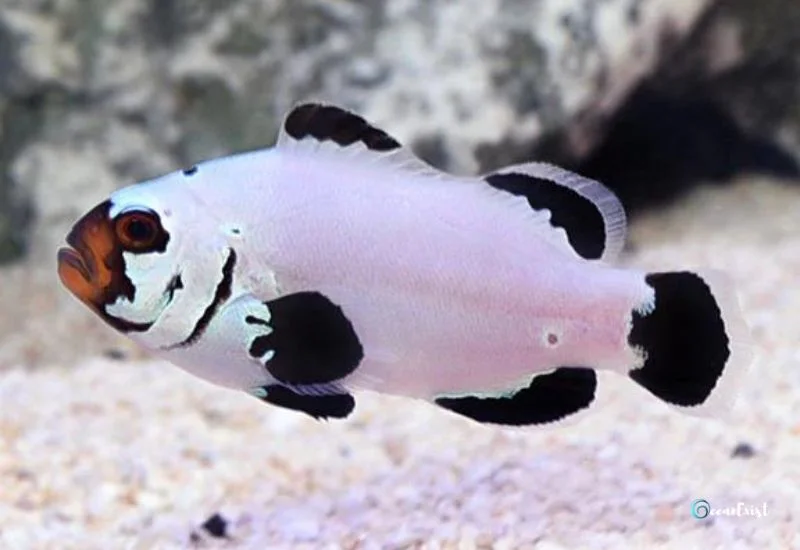
Frostbite Clownfish is a variant of the Ocellaris Clownfish. Many of the aquarists think these fish are the same.
They have unique white markings that look like frostbite on their orange. But, as it ages, the color becomes darker and darker.
They grow up to 3 inches in length.
- Scientific Name: Amphiprion ocellaris
- Colors: White with irregular black markings
- Weight: 5-12 grams
- Maximum Length: 3 inches (8 cm)
- Food/Diet: algae, plankton, and small crustaceans
- Tank Size: 10 gallons
- Lifespan: 6-8 years
15. Tomato Clownfish (Amphiprion frenatus)
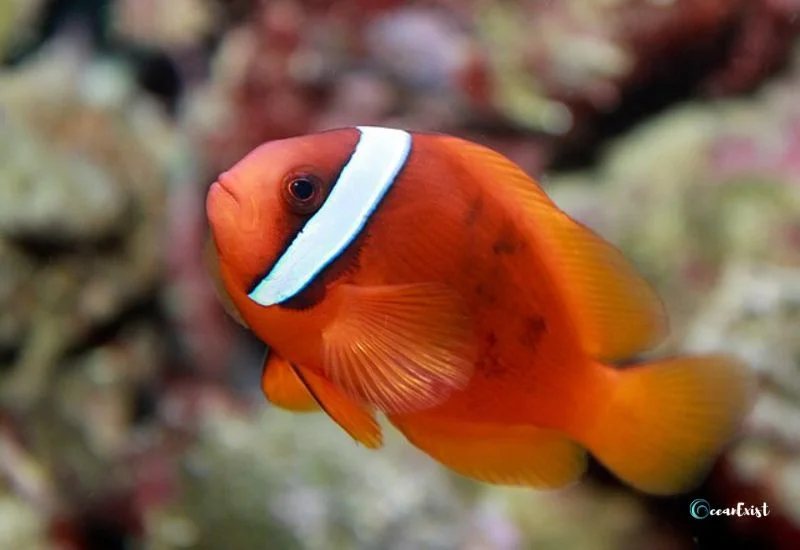
The Tomato Clownfish, named for their vivid red coloration, inhabits the Pacific and Indian Oceans. Round, fluffy body and bright reddish color win them the name tomato.
Their bright color and easy maintenance make them one of the most suitable aquarium pets. They have distinctive white bands outlining their bodies.
Mature fish have singles like broad white lines between gills, and juveniles have two. So, as they grow, the white line widens and becomes one at a certain age.
- Scientific Name: Amphiprion frenatus
- Colors: Bright red-orange
- Weight: 5-12 grams
- Maximum Length: 4 inches (10 cm)
- Food/Diet: algae, small invertebrates, and fish pellets
- Tank Size: 20 gallons
- Lifespan: 6-8 years
16. Clark’s Anemonefish (Amphiprion clarkii)

Clark’s Clownfish are characterized by their yellow-orange and multiple white bands. They are widely distributed throughout the Indo-Pacific region.
- Scientific Name: Amphiprion clarkii
- Colors: Yellow-orange with black margins on fins
- Weight: 5-12 grams
- Maximum Length: 4 inches (10 cm)
- Food/Diet: algae, plankton, and small crustaceans
- Tank Size: 20 gallons
- Lifespan: 6-8 years
17. Black Storm Clownfish (Amphiprion ocellaris)
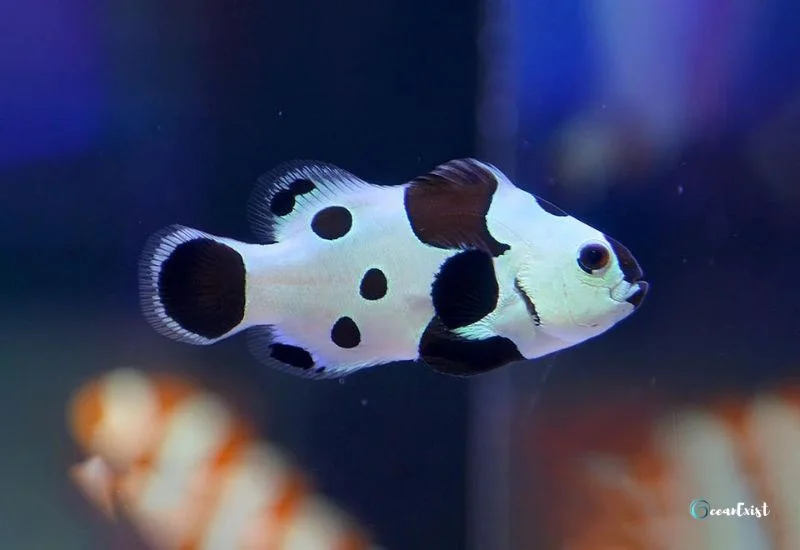
Black Storm Clownfish are one of the most common fish in the aquariums. They are black with white marks.
They are obtained by selective breeding. That is why they have rare body patterns. Black storms grow up to 3 inches, and their lifespan is around 6 to 8 centimeters.
- Scientific Name: Amphiprion ocellaris
- Colors: Black With irregular white markings
- Weight: 5-12 grams
- Maximum Length: 3 inches (8 cm)
- Food/Diet: algae, plankton, and small crustaceans
- Tank Size: 10 gallons
- Lifespan: 6-8 years
18. Cinnamon Clownfish (Amphiprion melanopus)
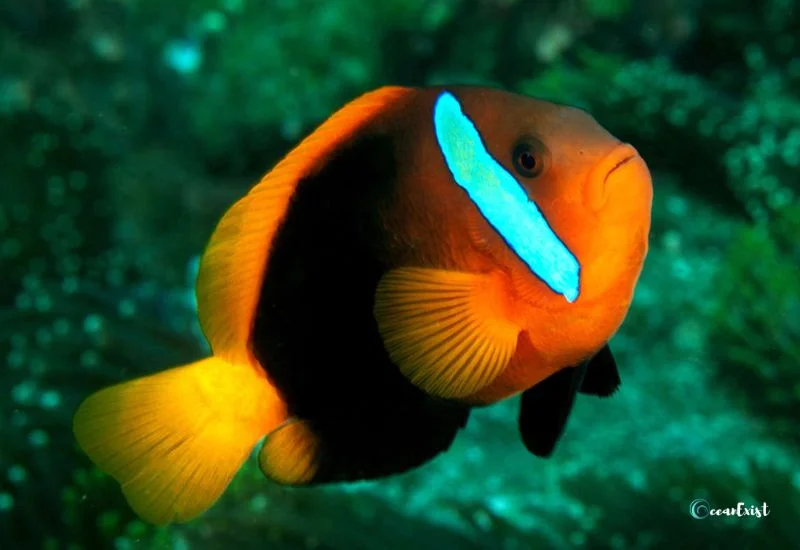
How beautiful and unusual fish they are! Cinnamon Clownfish showcase a warm cinnamon-brown color with thin white bands. They are native to the Western Pacific Ocean.
They are small fish of 3 inches that live in a small tank of 10 gallons. Anyone can get them for 20 to 40 dollars in the whole of America.
- Scientific Name: Amphiprion melanopus
- Colors: Cinnamon brown with white stripes
- Weight: 5-12 grams
- Maximum Length: 3 inches (8 cm)
- Food/Diet: algae, plankton, and small crustaceans
- Tank Size: 10 gallons
- Lifespan: 6-8 years
19. Mauritian Anemonefish (Amphiprion chrysogaster)
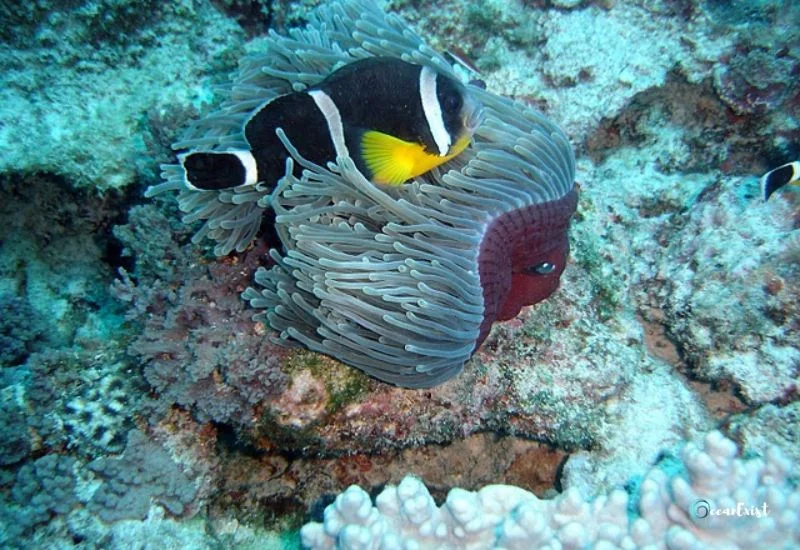
Mauritian Clownfish features a yellow-orange with two distinctive white bars. They are found in the waters of Mauritius.
They are medium-length clownfish that are 4 inches in length and live in small aquariums.
- Scientific Name: Amphiprion chrysogaster
- Colors: Orange with black margins on fins
- Weight: 5-12 grams
- Maximum Length: 4 inches (10 cm)
- Food/Diet: algae, plankton, and small crustaceans
- Tank Size: 20 gallons
- Lifespan: 6-8 years
20. Gold Nugget Maroon Clownfish (Premnas biaculeatus)
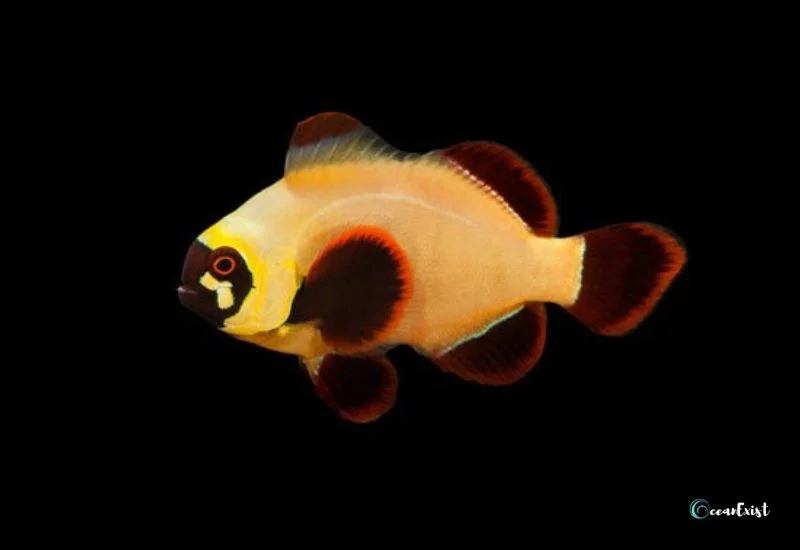
The Gold Nugget Maroon Clownfish exhibits a striking golden-yellow or red coloration with unique markings.
Because of their long body and deep colors, they are a prized addition to marine aquariums.
- Scientific Name: Premnas biaculeatus
- Colors: Deep red to maroon with white bands
- Weight: 10-20 grams
- Maximum Length: 6 inches (15 cm)
- Food/Diet: algae, small crustaceans, and fish flakes
- Tank Size: 30 gallons
- Lifespan: 6-8 years
Conclusion
Now you know all about 20 types of clownfish. Their bright colors and enormous size make them prominent among all the fish varieties.
Indeed, their addition to your reef will enhance the beauty of your aquarium. The bonus point is that clownfish are peaceful and hardy fish that will give you peace of mind.
With this well-structured and informative blog on different types of clownfish, pick the one that suits you the most.
It was all from our side. But if you have anything to add or leave a suggestion, please comment below.
If you liked this blog, let’s learn about the types of betta fish you might be looking for.
